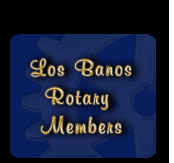




Los
Banos Rotary Club History
Rotarians Salute Cantaloupe Men
The highly specialized cantaloupe and melon industry of this community was saluted here Tuesday evening, as more than 20 of the industry's local growers and packers were hosted by the members of the Rotary Club at a dinner held at Recreation Hall.
Ross Brooks, dean of the local packers, was guest speaker at the program which followed the barbecued steak dinner. The program was arranged by Rotarian Randall Fawcett, local farmer and melon grower.
Pointing out the economic value of the industry to this city, Brooks traced back local carloadings to 1925 when a total of 25 carloads were shipped from this loading station. Until 1935 shipments continued light, with 35 cars shipped that year. In 1936, the year Brooks first came to Los Banos, rail shipments increased to 133 cars, of which 12 cars were shipped from Brooks shed.
By 1945 rail shipments from Los Banos had built up to 844 cars, and for the five year period 1946 to 1950 the average rail shipments were 1,356 cars. Average for the 1951-57 period was 1,682 cars.
A total of 21,724 carloads of melons were shipped from the Los Banos sheds for the entire period through 1957.
Brooks pointed out that these figures do not include shipments, have been growing steadily the past ten or twelve years, and on which no exact figures are available. He estimated that last year probably 35 per cent of the entire crop was shipped by truck, with an equal percentage being shipped this year. Brooks says the popularity of truck shipments is because of materially less transit time which puts the melons at the receiving city in fresher and better condition and consequently commands a warmer reception from the ultimate consumer.
Brooks related that the earlier history of the cantaloupe as a major commercial crop in California dates back to 1905, when the Imperial Valley of Southern California sprang into prominence as a melon-producing region, immediately following completion of a major irrigation canal system that transformed the previously desert region into an agricultural wonderland.
One thousand acres of melons were planted the first year and 297 carloads of melons were marketed. Shipments neared 2,000 cars by 1908, and had reached nearly 4,500 by 1914.
Following the lead set by Imperial Valley, Brooks related, cultivation of the cantaloupes spread to the Salt River and Yuma Valleys of Arizona.
Of California's fabulous West Side deal, Brooks quoted USDA reports showing that during the five year period 1943 through 1947 the average acreage planted to cantaloupes on the west side was 21,880. Average yield per acre was 159 crates, an average total production was 3,283,000 crates, with an average unit value of $3.28 per crate.
For the last five year period 1953-1957 the San Joaquin valley's west side average acreage was 27,720, average yield 155 crates average total production 4,285,000 crates, with a unit value of $3.65 per crate and average total annual value of $15,899,000.
Brooks said that figures covering just the Los Banos section are not available, but said the average yield per acre here is far greater that the averages for the entire west side, "All of us here," he said, "know that Los Banos raises the largest crops and the best quality melons on the West Side."
Of the cantaloupe's earlier history, Brooks said the cantaloupe is a variety of muskmelon, which dates back to Persia and to Egypt, where it was supposed to have been grown as early as 2400 B. C. Columbus carried its seeds on his second voyage to America and planted them here in 1494. They were grown in the first English colonies in Virginia and Massachusetts, and the Indians of Florida were growing them in the early 1600s.
Up to 1670 muskmelons were grown principally in private gardens, then gradually developed as a market product. The small, oval heavily netted green-fleshed Gem melon was introduced to the public in 1881, and by 1900 melons were being shipped to the New York market from as far west as Illinois.
Concluding Brooks' talk, chairman and Fawcett and Club president C. W. Bates emphasized to the melon men present the contribution they make to local business economy, and their appreciation at the clost cooperation and friendliness that has been extended to the community generally by the men who are engaged in the melon industry.
August 22, 1958
Los Banos Enterprise, Rotary Club 585 & Memorable Places Web Design of Los Banos


